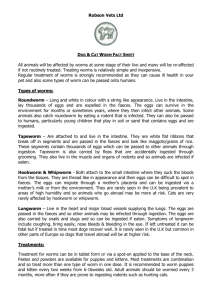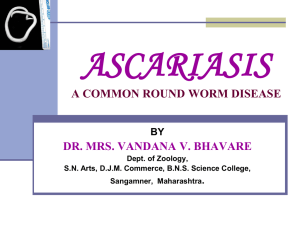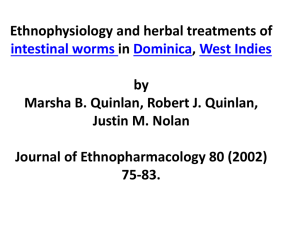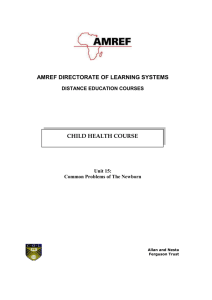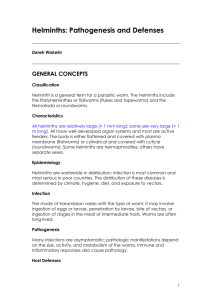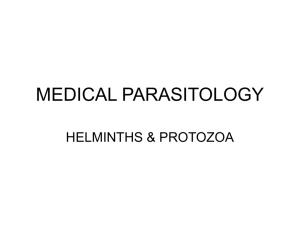File
advertisement
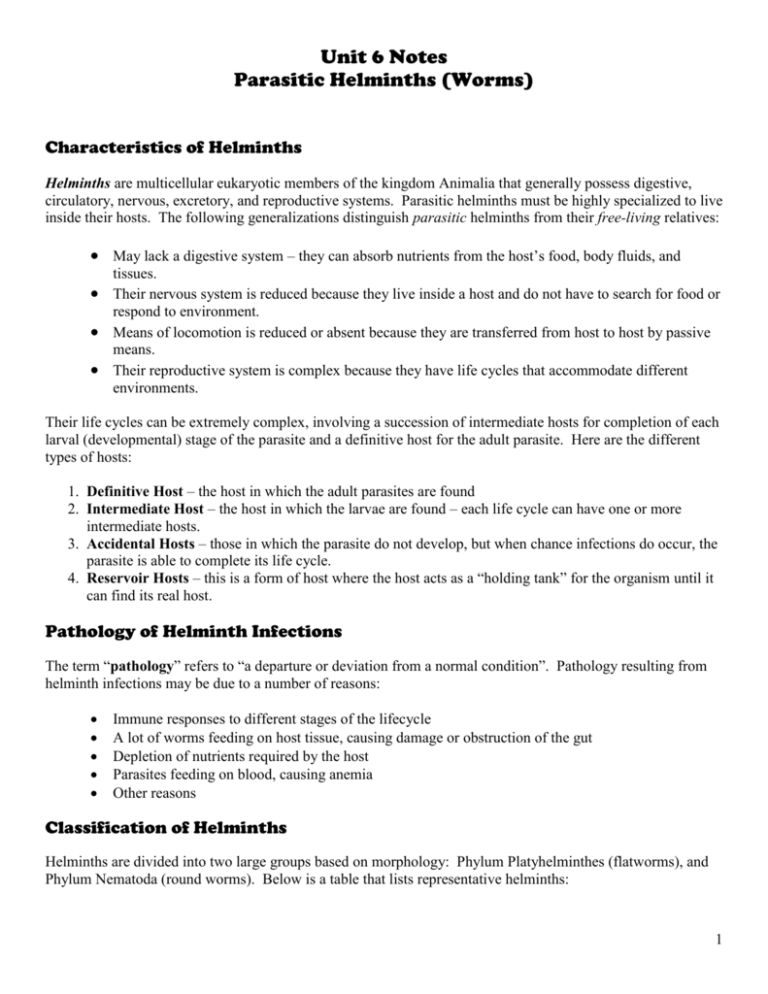
Unit 6 Notes Parasitic Helminths (Worms) Characteristics of Helminths Helminths are multicellular eukaryotic members of the kingdom Animalia that generally possess digestive, circulatory, nervous, excretory, and reproductive systems. Parasitic helminths must be highly specialized to live inside their hosts. The following generalizations distinguish parasitic helminths from their free-living relatives: May lack a digestive system – they can absorb nutrients from the host’s food, body fluids, and tissues. Their nervous system is reduced because they live inside a host and do not have to search for food or respond to environment. Means of locomotion is reduced or absent because they are transferred from host to host by passive means. Their reproductive system is complex because they have life cycles that accommodate different environments. Their life cycles can be extremely complex, involving a succession of intermediate hosts for completion of each larval (developmental) stage of the parasite and a definitive host for the adult parasite. Here are the different types of hosts: 1. Definitive Host – the host in which the adult parasites are found 2. Intermediate Host – the host in which the larvae are found – each life cycle can have one or more intermediate hosts. 3. Accidental Hosts – those in which the parasite do not develop, but when chance infections do occur, the parasite is able to complete its life cycle. 4. Reservoir Hosts – this is a form of host where the host acts as a “holding tank” for the organism until it can find its real host. Pathology of Helminth Infections The term “pathology” refers to “a departure or deviation from a normal condition”. Pathology resulting from helminth infections may be due to a number of reasons: Immune responses to different stages of the lifecycle A lot of worms feeding on host tissue, causing damage or obstruction of the gut Depletion of nutrients required by the host Parasites feeding on blood, causing anemia Other reasons Classification of Helminths Helminths are divided into two large groups based on morphology: Phylum Platyhelminthes (flatworms), and Phylum Nematoda (round worms). Below is a table that lists representative helminths: 1 Parasitic Helminth Diseases 1. Ascariasis – this is a disease caused by Ascaris lumbricoides, a large roundworm that resembles an earthworm. These worms live in the small intestine, and females can grow to over 1 foot in length! Infective eggs are passed onto the soil in the feces of infected individuals. When people ingest food or water contaminated with the eggs, they become infected. They mature in 2-3 months. Females produce 200,000 or more eggs per day. Most people experience no symptoms when infected, but damage to the lungs can occur when worms migrate to lung tissue. Adult worms can be coughed up and choke a person, or eliminated in feces. Can cause malnutrition from worms feeding on intestinal contents. Can also cause obstruction of intestine. As much as 25% of world’s population is infected with these, usually in areas where sanitation is poor. 2. Trichinellosis – this is a disease caused by Trichinella spiralis, a roundworm that lives in pork. People are infected with this when they eat raw or undercooked pork. When the infected meat is ingested, the hard covering of the worm cysts is digested, and the worms emerge in the small intestine. They mature in 1-2 days, and females can then lay more eggs. Larvae migrate into muscles, including eye, tongue, diaphragm, and chewing muscles, where they form more cysts. Symptoms occur within 1-2 days and include nausea, vomiting, fatigue, fever followed by headache, chills, aching muscles, and itchy skin. Can cause cardiac and respiratory problems in severe cases. Mild cases may never be diagnosed. 2 3. Dracunculiasis (Guinea Worm Disease) – caused by a roundworm called Dracunculus medinensis, this disease is contracted from contaminated drinking water. Mostly found in third world countries, this disease is usually seen about 1 year after ingestion of the unsafe water. The adult worms will eventually want to emerge from the body, usually in the legs and feet, and so will cause a large blister to spring up on the feet, and right before the worm emerges, the blister becomes very painful and swollen. The 3-foot or so worm that looks like a piece of spaghetti then begins to emerge from the blister, causing excruciating pain. You cannot pull the worm out, just wind it up on something as it comes out. It can take from 2 weeks to 3 months for the whole worm to emerge. If you break it off, you can be killed by life-threatening bacteria. Healing at the blister site takes 8 weeks – can cause permanent crippling. No medicine available. 4. Tapeworms – these are flatworms that are usually found in undercooked beef (Taenia saginata) or undercooked pork (Taenia solium). The beef tapeworm can reach 20-25 feet in length, and the pork tapeworm can reach 15-20 feet in length. The tapeworm attaches to human intestinal wall with suckers. Its body is made up of many proglottids, which are segments. Each worm has between 1000-2000 proglottids, and each can produce 80,000-100,000 eggs per proglottid. Proglottids detach from the worm and migrate to the anus, and are passed in the stool. Produce mild abdominal symptoms. 5. Filariasis (Elephantiasis) – threadlike worms, called filarial worms, cause this disease. These worms block the lymphatic vessels and cause the accumulation of large amounts of lymphatic fluid in the limbs, esp. in the legs. In males, may involve the genitals. In females, the breasts may be involved. The two worms responsible for this are Wuchereria bancrofti and Brugia malayi, and the worm is transmitted by mosquitoes. Early symptoms are chills, fever, and inflammation of lymph nodes. Causes permanent and long-term disability. Affects 120 million people worldwide, especially in Africa, Asia, and the western Pacific. 6. Hookworm disease – caused by a roundworm called Necator americanus in the US. Infection occurs by direct contact with contaminated soil. After 5-10 days, the larvae reach the infective stage and penetrate the skin, where they are carried to the lungs, coughed up, swallowed, and go back into the intestines where they produce more eggs that exit in the feces. They attach to the wall of the small intestine, thus the “hook”. Since they suck blood, they cause anemia, protein deficiency, and fatigue. Can lead to malnourishment. 7. Strongyloidiasis – caused by the roundworm Strongyloides stercoralis, this is also called the thread worm because of its small size. 800 million people worldwide are affected by this. Larvae in soil penetrate skin and transported to blood, heart, lungs, pharynx, where they are coughed up and swallowed, reaching the intestine. Symptoms include nausea, vomiting, anemia, weight loss, and chronic bloody diarrhea. 8. Enterobiasis (Pinworm disease) – the most common helminth disease in the US – 40 million are infected in the US alone. Caused by Enterobius vermicularis. Worms mate in the intestines, and at night, egg-bearing females exit the anus, lay eggs on skin, and die. Causes severe itching of the anus, which causes you to scratch. Eggs from fingernails are swallowed, causing re-infection. Symptoms include anal itching, restlessness, loss of appetite. “Scotch tape test” is how you diagnose. Treatable. 9. Schistosomiasis – also known as the blood flukes, these flatworms infect 200 million people worldwide. Mostly in developing countries. Caused by 3 organisms: Schistosoma japonicum, Schistosoma haematobium, or Schistosoma mansoni. Snails serve as the intermediate hosts in this life cycle. The snails release cercariae, or immature free-swimming larvae, into water. When you walk in infected water, the cercariae penetrate your skin, migrate into blood vessels, and in one week enter the liver. Migrate into veins of intestinal tract or bladder. Feed upon blood. Leave humans back into water by feces or urine. Adult worms can damage the brain, spinal cord, spleen, liver, lungs, intestine, and bladder, and cause the abdomen to become distended. Treatable but expensive. 3 Life Cycles of Worms You will be responsible for being able to read a life cycle diagram, and answer questions about it. Let’s go over one that is representative, and describe what is happening. The following life cycle is for a worm called Schistosoma sp.: 1. In step 1, at the bottom, is the beginning of the worm’s life cycle: the egg stage. You are shown pictures of the eggs of 3 different species of this worm. Notice that the eggs are in water (see picture of water waves). 2. In step 2, the eggs hatch, again in water, releasing the next stage in the life cycle, the miracidia. Miracidia are small, free-swimming larvae of some species of worms. 3. In step 3, we find the miracidia entering the first intermediate host, the snail, again in water. 4. In step 4, inside the snail, the larvae undergo asexual reproduction through a series of stages called sporocysts. 5. In step 5, after the asexual reproduction stage, cercaria (another free-swimming larva) are generated in large quantities, which then leave (shed into the environment) the snail and must infect a suitable vertebrate host in step 6. 6. In step 7, we see the cerceriae entering the circulation (blood stream) of host (step 8). 7. In step 9, we are gold that the worms mature into adults in the human liver, and in step 10, are shed back into the environment in the stool. 8. In this diagram, the human is the definitive host. 4


